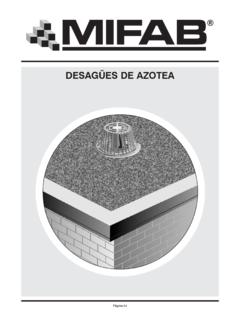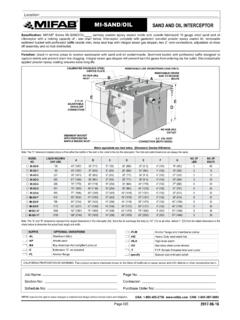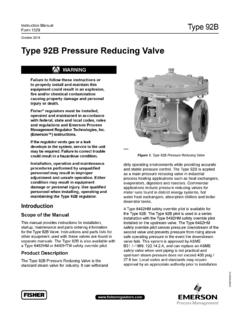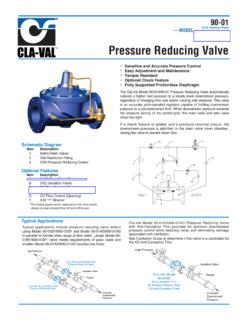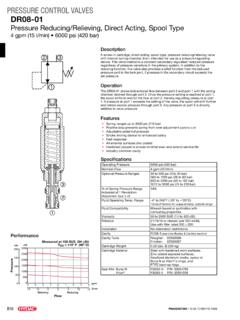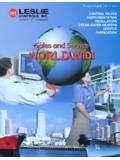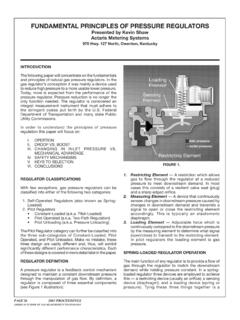Transcription of Pressure Reducing Control Valve - Mifab
1 5/17 OperationPressure Reducing Control ValveOPERATING INSTRUCTIONSBEECO, Inc. 1321 West 119th Street, Chicago, Illinois 60643-5109, USA Toll Free 800-465-2736 Fax Canada Toll Free: 1-800-387-3880 TYPICAL INSTALLATIONM odel ACV( )-HF-PRModel ACV( )-HF-HP-PRStandard ComponentsA Main ValveB Ball ValveC Pressure Reducing PilotF Self Cleaning StrainerG Pressure GaugeO Orifice / RestrictorS Adjustable Speed ControlV Air VentB1FB2 GVB3 SCOAThe Model PR reduces high Pressure from near zero to the maximum flow rate without the need for an additional Low-Flow Bypass. If the system is subjected to potentially static downstream conditions, a Pressure Relief Valve ( or larger) is recommended for additional system downstream Pressure setting can be changed by turning the Adjusting Screw of Pressure Reducing Pilot (C) clockwise (in) to increase or counterclockwise (out) to decrease the setting.
2 Pressure Gauge (G) indicates downstream Pressure setting. Speed of Valve operation/response is controlled by Speed Control (S) or Integral Needle Valve (N).A decrease in downstream Pressure below the adjustable setting of Pressure Reducing Pilot (C) causes the Valve to modulate toward an open position, raising downstream Pressure . An increase in downstream Pressure above the adjustable setting causes the Valve to modulate toward a closed position, lowering downstream BEECO Model PR Pressure Reducing Control Valve is a pilot controlled diaphragm Valve designed to reduce a fluctuating higher upstream Pressure to a constant lower downstream Pressure regardless of varying flow rates. It is controlled by Pressure Reducing Pilot (C) which internally senses downstream Pressure , and allows fluid out of the Main Valve (A) Control chamber when downstream Pressure is below the adjustable setting, and fluid to fill the main Valve Control chamber through Orifice / Restrictor (O) or Integral Needle Valve (N) when downstream Pressure is above the adjustable setting.
3 AB5/17 Pressure Reducing Control ValveOPERATING INSTRUCTIONSBEECO, Inc. 1321 West 119th Street, Chicago, Illinois 60643-5109, USA Toll Free 800-465-2736 Fax Canada Toll Free: 1-800-387-3880 Model ACV( )-HF-PRModel ACV( )-HF-HP-PR Model ACV( )-PRModel ACV( )-HF-PRModel ACV( )-HF-HP-PRModel ACV( )-PRStandard ComponentsA Main ValveB Ball ValveC Pressure Reducing PilotF Removable Self Cleaning StrainerG Pressure GaugeO Orifice / RestrictorS Adjustable Speed ControlV Air VentStandard ComponentsA Main ValveB Ball ValveC Pressure Reducing PilotF Removable Self Cleaning StrainerG Pressure GaugeN Integral Needle valves Adjustable Speed ControlV Air VentOB2GB1 FVB3 ACSB2B1VB3 ACFGN5/17 Pressure Reducing Control ValveOPERATING INSTRUCTIONSM odel ACV( )-HF-PRModel ACV( )-HF-HP-PRModel ACV( )-PR Close mainline isolation valves 1 and 2 (see Typical Installation on page 1).
4 Close downstream Ball Valve (B2) and open Ball valves (B1) & (B3). Turn Adjusting Screw of Pressure Reducing Pilot (C) OUT (counterclockwise), releasing all spring tension. Adjustable Speed Control (S) or Needle Valve (N): Loosen Jam Nut and turn the Needle IN (clockwise) until seated, then return OUT (counterclockwise) two full turns. This is an approximate setting and can be fine tuned to suit system requirements after Pressure adjustments are made. While keeping mainline isolation Valve 2 closed, slowly open mainline isolation Valve 1 to gradually pressurize Valve . When Valve is completely pressurized, fully open isolation Valve 1 . Verify upstream Pressure is higher than the desired set-point by at least 10 PSI. Release trapped air from the Control chamber by slightly opening Air Bleed (V).
5 Close when all air has been vented. Open mainline isolation Valve 2 . Verify there is adequate downstream demand for flow. Open Ball Valve (B2). While watching Pressure Gauge (G), slowly turn the Adjusting Screw of Pressure Reducing Pilot (C) IN (clockwise), pausing each 1/2 turn, until downstream Pressure reaches desired set-point. Turning the Adjustment Screw IN increases downstream Pressure . Turning Adjustment Screw OUT decreases downstream Pressure . Adjust Speed Control (S) or Needle Valve (N) as needed to fine tune Valve operation. Adjusting IN slows Valve response. Adjusting OUT increases Valve response. The Speed Control / Needle Valve can be open between 1/4 turn and fully open. Smaller opening may cause Valve to not regulate properly. Slightly increase and decrease downstream demand to insure Valve maintains set-point.
6 Adjust as needed to achieve desired set-point. Prior to installing the Valve flush line to remove any debris. Provide adequate clearance around and on top of Valve to allow for Valve service and maintenance procedures. The Control Piping system is normally factory installed on the Right Hand side of the Valve . If Control piping must be relocated due to installation requirements consult BEECO prior to any modifications. Install Valve horizontally (cover facing UP) so flow arrow matches flow through the line. Avoid installing valves 6" and larger vertically. Consult factory prior to ordering if installation is other than described. Install mainline inlet and outlet isolation valves . Install inlet and outlet Pressure gauges to monitor upstream and downstream pressures. If installation is subject to very low flow or potentially static conditions a Pressure Relief Valve (1/2" minimum) may be required downstream of the Pressure Reducing Valve for additional system , Inc.
7 1321 West 119th Street, Chicago, Illinois 60643-5109, USA Toll Free 800-465-2736 Fax Canada Toll Free: 1-800-387-3880 INSTALLATIONADJUSTMENT (for video instruction visit )Standard Horizontal Flow (all sizes)Vertical Flow Up (4" & smaller)RHLHI nletOutletControl Piping5/17 Pressure Reducing Control ValveOPERATING INSTRUCTIONSM odel ACV( )-HF-PRModel ACV( )-HF-HP-PRModel ACV( )-PRMANUAL OPERATION and MAINTENANCE The Valve can be set in a fixed position for maintenance of the Control circuit by sequentially closing Ball valves (B3), (B2) & (B1). When Ball Valve (B3) is closed the Valve will maintain its position. Automatic Control is cancelled when Ball Valve (B3) is closed. Return all Ball valves to the open position to resume automatic Control . The Valve can be manually closed by closing Ball Valve (B2) only.
8 Testing the Main Valve Diaphragm:1 - Close mainline isolation Valve 2 , leaving mainline isolation Valve 1 - Close Ball valves (B1), (B2) and (B3).3 - Remove Control Tubing from Ball Valve (B3) and slowly open. A volume of water will be expelled as the Control chamber vents to atmosphere and the Valve opens fully. A continuous discharge of water from Ball Valve (B3) indicates a worn Diaphragm. No further discharge from Ball Valve (B3) indicates Diaphragm integrity. Inspect and clean Strainer (F) as water quality dictates. Most clean water conditions will require inspection/servicing of Strainer (F) annually. During this operation mainline isolation valves 1 and 2 must be closed to isolate the Valve from line , Inc. 1321 West 119th Street, Chicago, Illinois 60643-5109, USA Toll Free 800-465-2736 Fax Canada Toll Free.
9 1-800-387-38805/17 Pressure Reducing Control ValveTROUBLESHOOTING GUIDELINESMAIN Valve DOES NOT OPENMAIN Valve DOES NOT CLOSEI nlet Pressure is lower than minimum operating pressureNo downstream demandBall valves (B2) or (B3) are closedDownstream Pressure is higher than set-pointBall valves (B1) or (B3) are closedOrifice/Nozzle (O) is cloggedStrainer (F) is cloggedDownstream Pressure is lower than set-pointDebris stuck under Main Valve SeatWorn Main Valve (A) DiaphragmWorn Reducing Pilot (C) Diaphragm (water discharging from Spring Housing vent hole)Verify mainline isolation Valve 1 is openVerify mainline isolation Valve 2 is openOpen all Ball ValvesVerify there is not a bypass Valve open or leaking Pressure downstream. Re-adjust Pressure set-point as neededOpen all Ball ValvesRemove, Clean, ReplaceRe-adjust Pressure Reducing Pilot (C) as neededRemove, Clean, ReplaceIsolate Valve from Pressure .
10 Disassemble Main Valve , Clean and Flush mainlineIsolate Valve from Pressure . Disassemble Main Valve and replace Diaphragm (using Main Valve Repair Kit)Repair/Replace Pressure Reducing Pilot (C)Model ACV( )-HF-PRModel ACV( )-HF-HP-PRModel ACV( )-PRBEECO, Inc. 1321 West 119th Street, Chicago, Illinois 60643-5109, USA Toll Free 800-465-2736 Fax Canada Toll Free: 1-800-387-3880 Speed Control (S) is clogged or closedVerify Needle is open 1/4 turn minimum. Adjust fully in and out to clear. Reset or return to original settingIntegral Needle Valve (N) or Speed Control (S) is clogged or closedVerify Needle is open 1/4 turn minimum. Adjust fully in and out to clear. Reset or return to original setting


